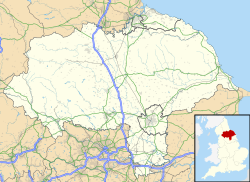Top Qs
Timeline
Chat
Perspective
Wilton, Ryedale
Village and civil parish in North Yorkshire, England From Wikipedia, the free encyclopedia
Remove ads
Wilton is a small village and civil parish near Pickering in North Yorkshire, England. The village is 4 miles (6.4 km) east of Pickering, 12 miles (19 km) west of Scarborough, and 10 miles (16 km) north-east of Malton.
Remove ads
History
Summarize
Perspective
Wilton is mentioned in the Domesday Book as belonging to William the Conqueror, and having 47 ploughlands and associated meadowland.[2] The name Wilton shares a common route with Wilton in what is now Redcar and Cleveland, and Bishop's Wilton in the East Riding. All are thought to be from Wildetuna, meaning waste; all three were described in the Domesday survey as having parts which were waste.[3] The Inclosure Act 1773 provided for up to 700 acres (280 ha) of land to be divided up.[4]
When the Forge Valley Line opened in 1882, a station was named Wilton, though it was in the parish of Allerston, 1.5 miles (2.4 km) south-east of Wilton.[5][6] This station was later renamed to Ebberston, c. 1903.[7] The nearest railway stations now are either at Malton to the south-west, or Scarborough and Seamer to the east.[8] The A170 road between Thirsk and Scarborough runs through the village, with up to eight buses per day each way between Pickering and Scarborough.[9] Wilton is 200 feet (61 m) above sea level, and 4 miles (6.4 km) east of Pickering, 12 miles (19 km) west of Scarborough, and 10 miles (16 km) north-east of Malton.[6][10]
The church was built between 1907 and 1908 by Charles Hodgson Fowler, replacing an earlier structure which burnt down. The previous church was a chapel-of-ease to the main church, the Church of St Hilda, within the old parish that Wilton fell under (Ellerburn).[11][12][13] The church is now a grade II listed building, and retains c. 13th century walls on the south side.[14][15] To the south and south-east of the church grounds are the remains of Wilton Hall moated site. This is a scheduled monument.[16]
Remove ads
Governance
Wilton was part of the Parish of Pickering until 1233, when it became part of the former civil parish of Ellerburn-cum-Farmanby.[17] The village came under the wapentake and liberty of Pickering Lythe, then later becoming part of the Pickering Rural District. In 1974, it was moved into the newer county of North Yorkshire (from the North Riding of Yorkshire),.[18] From 1974 to 2023 it was part of the district of Ryedale, it is now administered by the unitary North Yorkshire Council.[19][20] The village is represented at Westminster as part of the Thirsk and Malton Constituency.[21]
| 1801 | 1811 | 1821 | 1831 | 1841 | 1851 | 1861 | 1871 | 1881 | 1891 | 1901 | 1911 | 1921 | 1931 | 1951 | 1961 | 1971 | 2001 | 2011 | 2015 |
|---|---|---|---|---|---|---|---|---|---|---|---|---|---|---|---|---|---|---|---|
| 186 | 209 | 203 | 192 | 216 | 202 | 181 | 191 | 168 | 151 | 133 | 129 | 119 | 110 | 109 | 117 | 126 | 124 | 149 | 160[note 1] |
During the late 14th century, a poll tax was enacted to raise money for the war against the French. Wilton was assessed as having 13 dwellings with a population of 45.[26]
Remove ads
Notes
References
External links
Wikiwand - on
Seamless Wikipedia browsing. On steroids.
Remove ads


